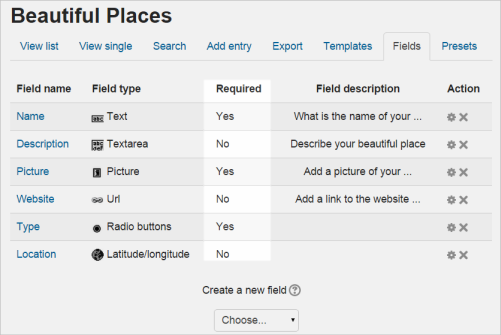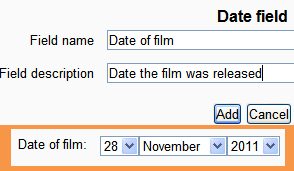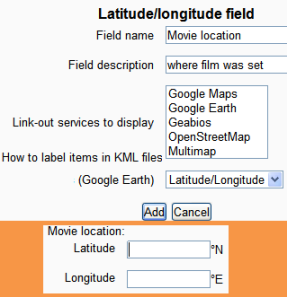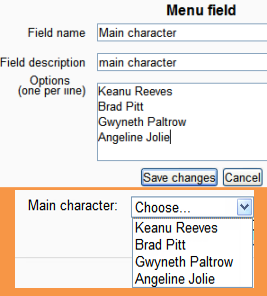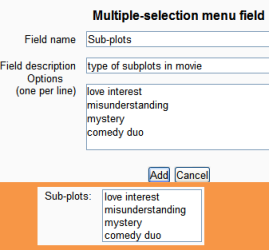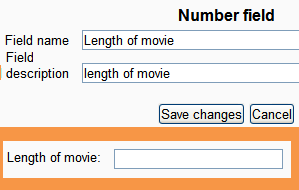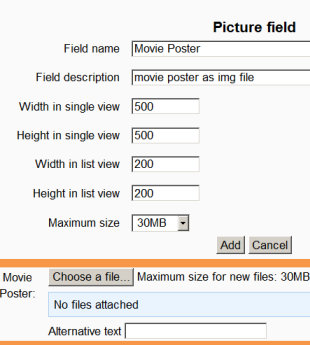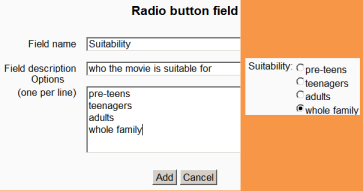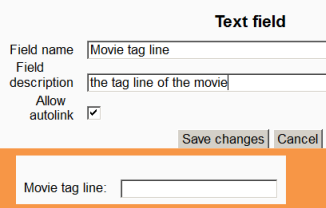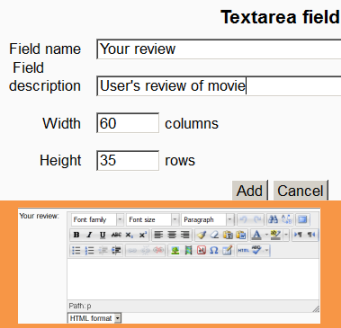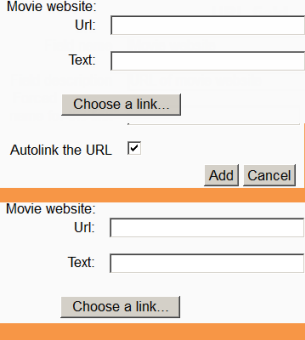Building Database: Difference between revisions
Mary Cooch (talk | contribs) (combined info from another page) |
Mary Cooch (talk | contribs) |
||
| (39 intermediate revisions by 8 users not shown) | |||
| Line 1: | Line 1: | ||
{{Database}} | {{Database}} | ||
After creating a database, as explained in [[Database activity settings]]... | After creating a database, as explained in [[Database activity settings]]... | ||
* Next you define the kind of | * Next you define the kind of fields that define the information you wish to collect. For example, a database of famous paintings may have a picture field called ''painting'', for uploading an image file showing the painting, and two text fields called ''artist'' and ''title'' for the name of the artist and the painting. Alternatively, you can use a database preset (see below). | ||
* It is then optional to edit the [[Database templates|database templates]] to alter the way in which the database displays entries. | * It is then optional to edit the [[Database templates|database templates]] to alter the way in which the database displays entries. | ||
==Database fields== | |||
A '''field''' is a named unit of information. Each entry in a [[Database activity module|database activity module]] can have multiple fields of multiple types e.g. a text field called 'favourite color' which allows you to type in your favourite shade, or a menu called 'state' that lets you choose one from a list of the 50 that make up the United States of America. By combining several fields with appropriate names and types you should be able to capture all the relevant information about the items in your database. | |||
Note that if you later edit the fields in the databases you must use the Reset template button, or manually edit the template, to ensure the new fields are added to the display. | |||
=== Field name and description === | |||
The name is what is shown when an entry is added. It must be unique and short. The description is for your benefit to help identify that field. | |||
===Required field=== | |||
If you need to ensure one or several particular fields are always completed, then tick the box 'Required field' when setting up the fields for your database. The field(s) will display a red asterisk when students contribute to the database, and they will not be able to save their work until they have entered the relevant information. A new column will show the teacher which fields are required and not: | |||
[[File:databaserequiredfields.png]] | |||
=== Field types === | |||
The following screenshots show "before" and "afters" of setting up fields. The selection in orange shows the field as it is displayed for the user when they add an entry. | |||
;Checkbox | |||
:This allows you to offer checkboxes for the user to select. Add the options one under the other. The word will appear next to a checkbox when the user clicks to add an entry. They can check more than one box. | |||
[[File:Checkboxfield1.png]] | |||
;Date | |||
:This allows a user to enter a date by picking a day, month and year from a drop down list. | |||
[[File:Datefield1.png]] | |||
;File | |||
:Users can upload a file from their computer. If it is an image file then the picture field may be a better choice. | |||
[[File:Filefield.png]] | |||
;Latitude/longitude | |||
:Users can enter a geographic location using latitude and longitude. For example, [http://moodle.com/hq/ Moodle HQ] is at latitude -31.9545, longitude 115.877. When viewing the record, links are automatically generated linking to geographic data services such as [http://earth.google.com Google Earth], [http://www.openstreetmap.org/ OpenStreetMap], [http://www.geabios.com/ GeaBios],[http://www.mapstars.com/extern/deltaworks-holland Mapstars] and more. (The teacher can choose which of those links appear, if any.) | |||
:Data input requirements: Data for this field must be input relative to North and East coordinates. To convert coordinates from West (e.g. 120W) to East, simply input them into the field with a '-' in front (e.g., -120). Also, data must also be input in decimal format, not degree format. Simple converters are a web search away. | |||
[[File:Latlongfield.png]] | |||
;Menu | |||
:The text entered in the ''options'' area will be presented as a drop-down list for the user to choose from. Each line become a different option. | |||
[[File:Menufield.png]] | |||
;Menu (Multi-select) | |||
:The text entered in the ''options'' area will be presented as a list for the user to choose from and each line become a different option. By holding down control or shift as they click, users will be able to select multiple options. This is a fairly advanced computer skill so it may be wise to use multiple checkboxes instead. | |||
[[File:Multiselectfield.png]] | |||
;Number | |||
:This allows users to enter any number. For example: | |||
* 42 | |||
* -1000 | |||
* 0 | |||
* 0.123 | |||
* 3.0e8 | |||
:(For those who care about the technical details, the field stores floating point numbers.) | |||
[[File:Numberfield.png]] | |||
;Picture | |||
:This allows a user to upload and display an image file. "Single view" is when the image is viewed on its own; "list view" is when it is viewed in with other images. Single view can be larger than list view. | |||
[[File:Picturefield.png]] | |||
;Radio buttons | |||
:The user gets radio buttons and can choose only one. They can only submit the entry when they have clicked on one button. (Note:If you only have two options and they are opposites (true/false, yes/no) then you could simply use a single checkbox instead. However checkboxes default to their unchecked status and so people could submit without actively selecting one of the options. This may not always be appropriate.) | |||
[[File:Radiofield.png]] | |||
;Text input | |||
:Users can enter text up to 60 characters in length. For longer text, or for text that requires formatting such as headers and bullet points, you can use a text area field. | |||
[[File:Textfield.png]] | |||
;Text area | |||
:This allows users to enter a long piece of text using the text editor. | |||
[[File:Textareafield.png]] | |||
;URL | |||
:The user can add a link to a website here. If you select ''autolink'' then the URL becomes clickable.. If you also enter a ''forced name for the link'' then that text will be used for the hyperlink. For example in a database of authors you may wish people to enter the author's website. If you enter the text 'homepage' as a forced name then clicking on text "homepage" will take you to the entered URL. | |||
You can choose to have the URL open in a new window if so desired. | |||
[[File:Urlfield.png]] | |||
After | ==Presets== | ||
If | |||
The Database activity offers four presets you can use or adapt instead of creating your own. Click the name of a preset to preview it and click the button Use preset bottom right to select your preferred preset. | |||
[[File:DBPresets.png|500px|thumb|center|Database presets]] | |||
===Importing a preset=== | |||
# When creating a new Database activity, click the button Import preset on the starter page once you have saved your settings. | |||
# Alternatively, click the link Presets in the Database activity navigation. | |||
# After the import, you can customise the fields and, if needed, add or import entries. . | |||
You will see a "Overwrite current settings" checkbox after the "Import" button has been pressed. If checked/ticked, the Database activity overwrites some of its current general settings by those stored in the preset. | |||
===Exporting a preset=== | |||
To share your Database activity, you have two options: | |||
#Export it as a zip file, which can then be imported to another course or Moodle site. To do this, click into your Database activity and then from the Templates link in the Database activity navigation, click the Actions menu, selecting Export preset. | |||
#Save as a preset, which publishes the Database for other teachers on your site to use. It will then appear in the preset list. (You can delete it from the list at any time.) To do this,from the Templates link in the Database activity navigation, click the Actions menu, selecting Publish preset on this site. | |||
[[File:ExportPublishPreset.png|500px|thumb|center|Preset options]] | |||
Note: Only the fields and templates of the database are copied when exporting or saving it as a preset, not the entries. | |||
===Presets for download=== | |||
You can browse other presets from the [https://moodle.net/collection/dw7n7v56rcye-moodle-database-presets Database presets collection on Moodle.net]. You can create your own presets as well and share them with others. | |||
==See also== | ==See also== | ||
[[de:Datenbank erstellen]] | |||
[[es:Construyendo BasedeDatos]] | |||
[[fr:Construire une base de données]] | |||
Latest revision as of 06:35, 3 April 2023
After creating a database, as explained in Database activity settings...
- Next you define the kind of fields that define the information you wish to collect. For example, a database of famous paintings may have a picture field called painting, for uploading an image file showing the painting, and two text fields called artist and title for the name of the artist and the painting. Alternatively, you can use a database preset (see below).
- It is then optional to edit the database templates to alter the way in which the database displays entries.
Database fields
A field is a named unit of information. Each entry in a database activity module can have multiple fields of multiple types e.g. a text field called 'favourite color' which allows you to type in your favourite shade, or a menu called 'state' that lets you choose one from a list of the 50 that make up the United States of America. By combining several fields with appropriate names and types you should be able to capture all the relevant information about the items in your database.
Note that if you later edit the fields in the databases you must use the Reset template button, or manually edit the template, to ensure the new fields are added to the display.
Field name and description
The name is what is shown when an entry is added. It must be unique and short. The description is for your benefit to help identify that field.
Required field
If you need to ensure one or several particular fields are always completed, then tick the box 'Required field' when setting up the fields for your database. The field(s) will display a red asterisk when students contribute to the database, and they will not be able to save their work until they have entered the relevant information. A new column will show the teacher which fields are required and not:
Field types
The following screenshots show "before" and "afters" of setting up fields. The selection in orange shows the field as it is displayed for the user when they add an entry.
- Checkbox
- This allows you to offer checkboxes for the user to select. Add the options one under the other. The word will appear next to a checkbox when the user clicks to add an entry. They can check more than one box.
- Date
- This allows a user to enter a date by picking a day, month and year from a drop down list.
- File
- Users can upload a file from their computer. If it is an image file then the picture field may be a better choice.
- Latitude/longitude
- Users can enter a geographic location using latitude and longitude. For example, Moodle HQ is at latitude -31.9545, longitude 115.877. When viewing the record, links are automatically generated linking to geographic data services such as Google Earth, OpenStreetMap, GeaBios,Mapstars and more. (The teacher can choose which of those links appear, if any.)
- Data input requirements: Data for this field must be input relative to North and East coordinates. To convert coordinates from West (e.g. 120W) to East, simply input them into the field with a '-' in front (e.g., -120). Also, data must also be input in decimal format, not degree format. Simple converters are a web search away.
- Menu
- The text entered in the options area will be presented as a drop-down list for the user to choose from. Each line become a different option.
- Menu (Multi-select)
- The text entered in the options area will be presented as a list for the user to choose from and each line become a different option. By holding down control or shift as they click, users will be able to select multiple options. This is a fairly advanced computer skill so it may be wise to use multiple checkboxes instead.
- Number
- This allows users to enter any number. For example:
- 42
- -1000
- 0
- 0.123
- 3.0e8
- (For those who care about the technical details, the field stores floating point numbers.)
- Picture
- This allows a user to upload and display an image file. "Single view" is when the image is viewed on its own; "list view" is when it is viewed in with other images. Single view can be larger than list view.
- Radio buttons
- The user gets radio buttons and can choose only one. They can only submit the entry when they have clicked on one button. (Note:If you only have two options and they are opposites (true/false, yes/no) then you could simply use a single checkbox instead. However checkboxes default to their unchecked status and so people could submit without actively selecting one of the options. This may not always be appropriate.)
- Text input
- Users can enter text up to 60 characters in length. For longer text, or for text that requires formatting such as headers and bullet points, you can use a text area field.
- Text area
- This allows users to enter a long piece of text using the text editor.
- URL
- The user can add a link to a website here. If you select autolink then the URL becomes clickable.. If you also enter a forced name for the link then that text will be used for the hyperlink. For example in a database of authors you may wish people to enter the author's website. If you enter the text 'homepage' as a forced name then clicking on text "homepage" will take you to the entered URL.
You can choose to have the URL open in a new window if so desired.
Presets
The Database activity offers four presets you can use or adapt instead of creating your own. Click the name of a preset to preview it and click the button Use preset bottom right to select your preferred preset.
Importing a preset
- When creating a new Database activity, click the button Import preset on the starter page once you have saved your settings.
- Alternatively, click the link Presets in the Database activity navigation.
- After the import, you can customise the fields and, if needed, add or import entries. .
You will see a "Overwrite current settings" checkbox after the "Import" button has been pressed. If checked/ticked, the Database activity overwrites some of its current general settings by those stored in the preset.
Exporting a preset
To share your Database activity, you have two options:
- Export it as a zip file, which can then be imported to another course or Moodle site. To do this, click into your Database activity and then from the Templates link in the Database activity navigation, click the Actions menu, selecting Export preset.
- Save as a preset, which publishes the Database for other teachers on your site to use. It will then appear in the preset list. (You can delete it from the list at any time.) To do this,from the Templates link in the Database activity navigation, click the Actions menu, selecting Publish preset on this site.
Note: Only the fields and templates of the database are copied when exporting or saving it as a preset, not the entries.
Presets for download
You can browse other presets from the Database presets collection on Moodle.net. You can create your own presets as well and share them with others.
